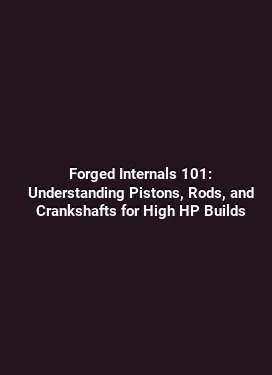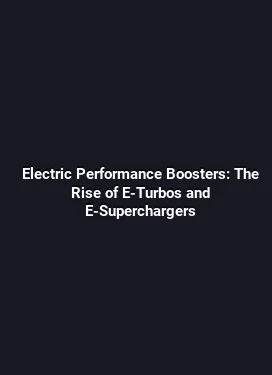Rotrex C38-81 Supercharger Installation for BMW E36 M3: Engine & Performance Review
The BMW E36 M3 remains a benchmark for enthusiasts seeking a raw, driver-focused experience. Enhancing its naturally aspirated engine with a forced induction system can unlock a new realm of performance while preserving the car's balanced chassis. This article delves into the Rotrex C38-81 supercharger kit as a practical upgrade path for the E36 M3, examining installation workflow, engine management considerations, real-world performance gains, and maintenance implications. The discussion emphasizes thorough preparation, careful component matching, and long-term reliability to ensure the upgrade delivers tangible improvements without compromising drivability.
Overview of the Rotrex C38-81 System and Its Fit for the E36 M3

The Rotrex C38-81 is a centrifugal supercharger unit known for smooth boost delivery, compact packaging, and efficient cooling characteristics. When paired with a well-designed pulley ratio and an appropriate intercooling strategy, the system can provide meaningful horsepower and torque gains across a broad rpm range. The E36 M3, with its inline six engine and lightweight chassis, responds well to forced induction when matched with robust fueling, reliable ignition, and precise air-fuel control.
Key attributes of the C38-81 kit include a compact rotor housing, a high-efficiency belt-driven drive system, and an integrated clutch mechanism that promotes progressive boost response. For enthusiasts, this translates to a more engaging driving experience without the abrupt surge that some larger, traditional superchargers can introduce. In practice, the C38-81 enables an increase in mid-range torque, improving acceleration in everyday driving and track-like scenarios while preserving a natural throttle transition for street use.
Kit Compatibility and Component Considerations

Successful integration hinges on precise compatibility checks. The E36 M3’s engine bay layout requires careful planning of hose routes, intercooler placement, and intake tract geometry to minimize pressure losses. The Rotrex system relies on a robust air-to-air or air-to-water intercooling path to manage intake temperatures, particularly under sustained boost conditions. Compatibility also extends to fuel system capability, calibration hardware, and engine management interfaces that can accommodate altered maps and sensor expectations.
Beyond the core blower, attention to the bracketry, pulleys, and belt tensioning is crucial. A well-engineered mounting system reduces vibration transmission and ensures consistent belt alignment under load. Cooling system upgrades or optimizations may be necessary when the vehicle experiences higher thermal loads, such as on a closed-road or track environment. Each of these considerations contributes to repeatable performance and long-term reliability.
Installation Workflow: From Planning to First Start
Approaching the installation with a structured workflow helps avoid common pitfalls and ensures that the upgrade integrates cleanly with the existing engine systems. A methodical plan typically includes documentation of baseline engine conditions, a parts inventory, and a staged testing regime to verify each subsystem before moving to the next step. While individual installations vary, the core stages remain consistent: removal of legacy components, fabrication of any new brackets or lines, assembly of the Rotrex unit, plumbing of the intercooler and intake tract, fuel and ignition recalibration, and finally a cautious initial startup with progressive testing.
During the initial phase, engine health checks are essential. A compression test, leak-down assessment, and verification of cooling flow help establish a baseline. With the supercharger physically installed, the focus shifts to air and fuel plumbing, ensuring air leaks are eliminated and that the intake path remains as short and straight as possible to minimize lag. The intercooler placement should prioritize efficient heat rejection, with attention paid to ducting quality, end tanks, and coolant routing if an air-to-water solution is used.
Dynamic Considerations During First Start
When powering the system for the first time, the priority is a controlled, staged engagement of boost. An initial conservative tune reduces the risk of detonation and allows the engine management system to learn the updated airflow characteristics. This phase should be conducted with proper instrumentation, including wideband oxygen sensing, fuel pressure monitoring, and, if possible, a data-logging setup to capture throttle position, manifold pressure, and ignition timing under varying load conditions.
Fine-tuning emerges as boost targets are gradually increased. Small, incremental changes to fuel trims and ignition timing can unlock power while maintaining safe operating margins. It is crucial to confirm that the cooling system keeps intake temperatures within a safe window under peak boost. For many drivers, a balanced blend of drivability and performance is achieved when the system provides linear throttle response and predictable boost onset across the rev range.
Engine Management, Fueling, and Ignition Strategy
Achieving reliable performance gains from the Rotrex C38-81 requires thoughtful changes to fueling and ignition strategies. The E36 M3’s stock engine management was designed for naturally aspirated operation, so the installation typically necessitates an upgraded ECU calibration, or a compatible piggyback/standalone solution, to manage altered air mass flow and boost. Precision in fueling is critical; the goal is to maintain stoichiometric or slightly rich mixtures at higher loads to protect the engine from detonation while supporting power production.
Beyond fueling, ignition timing must be revised to accommodate the new pressure and temperature conditions within the combustion chamber. A conservative timing map during the initial boost ramp helps prevent pre-ignition under low-octane fuel or high ambient temperatures. Over time, a data-driven approach enables gradual optimization, balancing performance and reliability. It is also advisable to reevaluate the reliability of the engine’s cooling system, as boost introduces additional thermal stress, particularly on the cylinder head gasket and contributing components.
Fuel System Upgrades and Sensor Integration
Many E36 M3 installations benefit from a higher-capacity fuel pump and updated injectors to maintain safe air-fuel ratios under boost. The goal is not merely adding fuel volumes but achieving a stable and precise delivery across RPMs and load conditions. Accurate fuel pressure regulation, injector dead-time awareness, and proper return-line design contribute to repeatable performance. Sensor upgrades, such as a calibrated mass air flow sensor (or a suitable alternative in a tuning solution) and enhanced manifold pressure sensing, provide the engine management system with reliable data for responsive control during boost transitions.
Integration with the vehicle’s existing diagnostics and fault handling is essential. A robust data logging setup helps capture potential issues early, including misfires, lean conditions, or fuel delivery anomalies. For daily driving, the aim is a seamless, predictable power curve with minimal throttle hesitation and stable idle characteristics when the vehicle is not under boost.
Performance Gains: Real-World Driving and Track-Oriented Scenarios
Owners who pursue the Rotrex C38-81 upgrade typically seek a tangible uplift in mid-range torque, improved acceleration, and a more engaging driving experience without sacrificing everyday usability. In practice, the kit can deliver noticeable gains across the rpm range, especially from mid to upper revs where the engine benefits from forced induction. The exact horsepower and torque outcomes depend on factors such as pulley choice, intercooling efficiency, fuel system capability, and ignition mapping.
On the street, you may observe quicker throttle response, smoother power delivery, and a more composed linear boost feel. On a closed course or track, the upgrade often translates to faster lap times, more confident corner exits, and improved hill-climb performance, provided the chassis is balanced to cope with the increased power. The E36 M3’s renowned handling characteristics pair well with the enhanced drivetrain performance, assuming suspension setups, brakes, and tires are aligned with the upgraded powertrain.
Track Versus Street Tuning: Practical Differences
Street tuning prioritizes drivability and reliability, keeping boost within conservative limits and prioritizing low-end torque for everyday acceleration. Track tuning, conversely, emphasizes repeatable power delivery at sustained high loads, robust cooling, and comprehensive data logging to support aggressive fueling and ignition maps. In track scenarios, cooling performance becomes a limiting factor, making intercooling and heat management decisions critical to maintaining performance across multiple laps.
Another practical consideration is throttle modulation. A well-calibrated system provides predictable boost onset with minimal lag, allowing drivers to manage traction effectively during corner entry and exit. This predictability contributes to a more confident driving experience and can reduce the likelihood of wheel spin on high-traction surfaces or during aggressive throttle applications.
Reliability, Maintenance, and Long-Term Considerations
Long-term reliability hinges on consistent maintenance practices and adherence to manufacturer guidelines for drive belts, tensioning, and intercooler integrity. Routine inspection of hoses, clamps, and fittings helps prevent boost leaks, which can undermine performance and engine health. Regular checks of the cooling system, including radiator efficiency and intercooler performance, are essential to avoid overheating under sustained boost conditions.
Lubrication quality for the Rotrex unit, belt wear monitoring, and ensuring clean intake paths are essential maintenance tasks. Debris management in the air intake area and meticulous vacuum line checks help preserve the efficiency of the forced induction system. A proactive maintenance approach reduces the risk of performance degradation over time and helps maintain a consistent driving experience.
From a reliability perspective, the compatibility of engine internals with boosted operation should be confirmed. Components such as pistons, rods, and the head gasket can influence the long-term success of the upgrade, particularly when operating at higher boost levels or with aggressive timing maps. A conservative boost strategy paired with high-quality fueling and cooling provides a balanced path to durability while still delivering meaningful performance gains.
Common Challenges and Troubleshooting Tips
Boost-related installations can present unique challenges. Common issues include boost leaks, intercooler bottlenecks, fuel delivery instability, and ignition timing irregularities. A systematic approach to troubleshooting—starting with leak checks, verifying sensor readings, and confirming the integrity of the calibration—helps identify root causes efficiently.
If detonation occurs, evaluate fuel quality, octane rating, and timing margins. Reassessing intercooling efficiency and air intake routing can also help reduce inlet temperatures that contribute to knock. In cases where idle stability is affected, inspect vacuum lines and the idle control system, ensuring there are no leaks or sensor insensitivity at idle RPMs. Consistent data logging can reveal trends that inform map adjustments and component refinements.
Preventive Practices for Sustained Performance
Preventive measures include routine inspection of the belt drive system, ensuring the pulley ratio remains aligned with the calibration goals, and verifying that all connections are secure under varying temperatures and loads. Keeping the fuel system clean and free of contaminants supports reliable injection and combustion. Regular maintenance, paired with disciplined driving under boost, is a practical path to preserving performance gains and minimizing downtime.
In summary, a well-executed Rotrex C38-81 installation on the BMW E36 M3 offers a meaningful performance uplift with a focus on drivability and reliability. When combined with a thoughtful engine management strategy, robust fuel delivery, and careful cooling design, the upgrade delivers a compelling balance of street manners and track-ready capability, all while respecting the car’s iconic driving dynamics.






